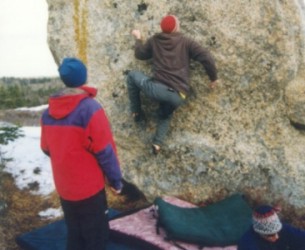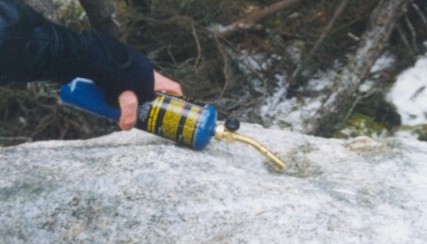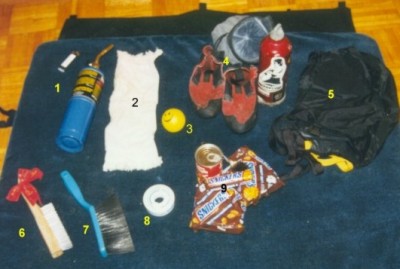


[1] Acclimatize yourself to the cold. Spend time outside, whether it be a daily stroll or a backwoods hike, to allow your body to adjust to colder temperatures. You cannot climb in a parka and you cannot climb with gloves on, so if you want to be comfortable you need to get your body used to the cooler temperatures.
[2] Dress appropriately. Ware layers that can be taken off as you worm up or put back on
when you start felling cold. It is a good idea for your bottom layer to be wicking fabric which
draws moister away from your skin and drys easily. Even in cold weather you may sweat while
cranking. Your top layer should be impermeable to wind. I ware a leather jacket, others prefer a
winter cote. I am told it is a good idea to ware long johns.

[3] Pre climb warmup. It is hard to warmup in the cold. One thing that can help is to squeeze a soft foam rubber ball on your way to the bouldering location. This will warmup your hands and forearms which receive the most abuse while you are climbing. Another idea is to do your warmup at an indoor gym before heading out.
[4] Choice of location. Pick a site which is sheltered and sunny. Wind will make things a lot colder and can caws other problems as well (see Torch), so pick a spot out of the wind. An area which is south facing or gets lots of sun will generally be warmer and have less snow on the boulders.
[5] Bring food. You burn more calories in the cold. If you go too long without eating you will
not just get hungry, you will get cold. When you are hungry your body is lacking the fuel it needs
to produce body heat.

[6] Torch. I thought it was a joke when I first heard of it, but yes, boulderers really do use blowtorches to remove snow and ice from the rock and to dry out the holds. If you choose your location well you usually will not need to use the torch much. A plumbers torch will only do so much. It is effective for small holds, but it would take you all day to dry a large smearing (beached whale type) top-out like the one shown here. It is best to remove as much of the snow and ice as possible with a wire brush or other tools before you use the torch. Once the snow/ice is melted you can speed things up by drying the area with a towels or rag, then use the torch again to finish. Strong winds are likely to blow out the torch (see Choice of Location).
[7] Heater. A heat source, such as a small Colman heater, can make climbing in the cold a lot more pleasant, and increase your odds of actually sending the problem you went out there to do. It is nice if you find a sheltered nook that you can heat up a little, but the main idea is just to be able to heat up your shoes.
[8] Bring a small tarp. A small tarp (I use my rope tarp) is useful to lay your stuff on so it
does not get wet. If you do not have a tarp you tend to lay your stuff on you crash pad which is
counter productive. A tarp can also be useful for keeping your crash pad dry. Use a canvas or
fabric tarp. Plastic gets brittle in the cold and will tear.

[1] Torch (drying the rock)
[2] Towel or rag (sop up melt water from sun or torch)
[3] Squeeze ball (warmup on the way in)
[4] Your climbing stuff
[5] Tarp (to lay your gear on)
[6] Wire brush (clearing off snow and ice)
[7] Whisk broom (removing fluffy snow, less effective than wire brush)
[8] Medical tape (for taping shredded fingers)
[9] Food (Fuel your body for energy and warmth)
Webmaster: tethc@yahoo.com
Last updated: Dec 4, 2001